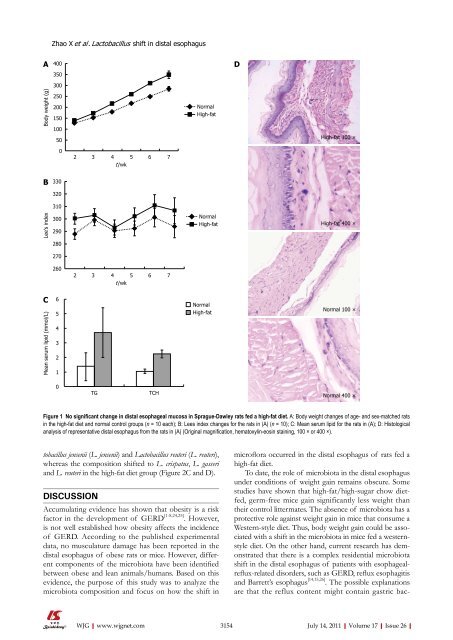26 - World Journal of Gastroenterology
26 - World Journal of Gastroenterology
26 - World Journal of Gastroenterology
Create successful ePaper yourself
Turn your PDF publications into a flip-book with our unique Google optimized e-Paper software.
A 400<br />
Body weight (g)<br />
B<br />
Lee’s index<br />
C<br />
Mean serum lipid (mmol/L)<br />
Zhao X et al . Lactobacillus shift in distal esophagus<br />
350<br />
300<br />
250<br />
200<br />
150<br />
100<br />
50<br />
0<br />
330<br />
320<br />
310<br />
300<br />
290<br />
280<br />
270<br />
<strong>26</strong>0<br />
6<br />
5<br />
4<br />
3<br />
2<br />
1<br />
0<br />
Figure 1 No significant change in distal esophageal mucosa in Sprague-Dawley rats fed a high-fat diet. A: Body weight changes <strong>of</strong> age- and sex-matched rats<br />
in the high-fat diet and normal control groups (n = 10 each); B: Lees index changes for the rats in (A) (n = 10); C: Mean serum lipid for the rats in (A); D: Histological<br />
analysis <strong>of</strong> representative distal esophagus from the rats in (A) (Original magnification, hematoxylin-eosin staining, 100 × or 400 ×).<br />
tobacillus jensenii (L. jensenii) and Lactobacillus reuteri (L. reuteri),<br />
whereas the composition shifted to L. crispatus, L. gasseri<br />
and L. reuteri in the high-fat diet group (Figure 2C and D).<br />
DISCUSSION<br />
2 3 4 5 6 7<br />
t /wk<br />
2 3 4 5 6 7<br />
t /wk<br />
TG TCH<br />
Accumulating evidence has shown that obesity is a risk<br />
factor in the development <strong>of</strong> GERD [1-8,24,25] . However,<br />
is not well established how obesity affects the incidence<br />
<strong>of</strong> GERD. According to the published experimental<br />
data, no musculature damage has been reported in the<br />
distal esophagus <strong>of</strong> obese rats or mice. However, different<br />
components <strong>of</strong> the microbiota have been identified<br />
between obese and lean animals/humans. Based on this<br />
evidence, the purpose <strong>of</strong> this study was to analyze the<br />
microbiota composition and focus on how the shift in<br />
WJG|www.wjgnet.com<br />
Normal<br />
High-fat<br />
Normal<br />
High-fat<br />
Normal<br />
High-fat<br />
D<br />
High-fat 100 ×<br />
High-fat 400 ×<br />
Normal 100 ×<br />
Normal 400 ×<br />
micr<strong>of</strong>lora occurred in the distal esophagus <strong>of</strong> rats fed a<br />
high-fat diet.<br />
To date, the role <strong>of</strong> microbiota in the distal esophagus<br />
under conditions <strong>of</strong> weight gain remains obscure. Some<br />
studies have shown that high-fat/high-sugar chow dietfed,<br />
germ-free mice gain significantly less weight than<br />
their control littermates. The absence <strong>of</strong> microbiota has a<br />
protective role against weight gain in mice that consume a<br />
Western-style diet. Thus, body weight gain could be associated<br />
with a shift in the microbiota in mice fed a westernstyle<br />
diet. On the other hand, current research has demonstrated<br />
that there is a complex residential microbiota<br />
shift in the distal esophagus <strong>of</strong> patients with esophagealreflux-related<br />
disorders, such as GERD, reflux esophagitis<br />
and Barrett’s esophagus [14,15,<strong>26</strong>] . The possible explanations<br />
are that the reflux content might contain gastric bac-<br />
3154 July 14, 2011|Volume 17|Issue <strong>26</strong>|

















